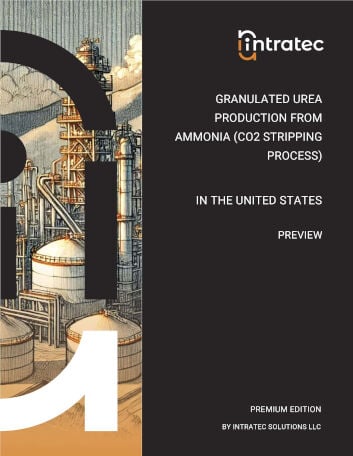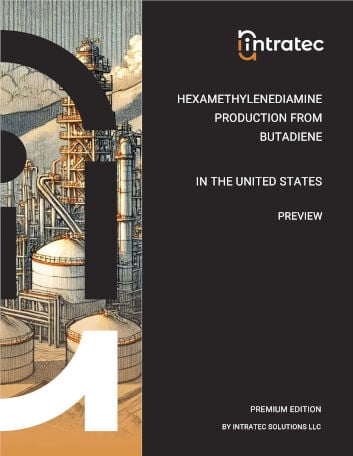Commodity Production Costs Report
Hexamethylene Diisocyanate from HMDA (Non-Phosgene Process)
HDI Plant Capital & Operating Cost Analysis | United States | Q3 2025
This report presents the economics of Hexamethylene Diisocyanate (HDI) production from hexamethylene diamine (HMDA) and urea. The process examined is a non-phosgene technology similar to the one developed by BASF. In this process, HMDA reacts with urea and butanol generating a carbamate intermediate. Then, the carbamate is thermally cracked producing HDI.
The report provides a comprehensive study of HDI production and related HDI production cost, covering three key aspects: a complete description of the HDI production process examined; an in-depth analysis of the related HDI plant capital cost (Capex); and an evaluation of the respective HDI plant operating costs (Opex).
The HDI production process description includes a block flow diagram (BFD), an overview of the industrial site installations, detailing both the process unit and the necessary infrastructure, process consumption figures and comprehensive process flow diagrams (PFD). The HDI plant capital cost analysis breaks down the Capex by plant cost (i.e., ISBL, OSBL and Contingency); owner's cost; working capital; and costs incurred during industrial plant commissioning and start-up. The HDI plant operating costs analysis covers operating expenses, including variable costs like raw materials and utilities, and fixed costs such as maintenance, labor, and depreciation.

The process under analysis comprises two major sections: (1) carbamate production; (2) carbamate purification; and (3) thermal cleavage.
Carbamate production. Urea, hexamethylenediamine and butanol are mixed, preheated and routed to reactors. The reaction of such compounds is carried out in a three-stage stirred reactor, in the presence of catalysts based on zirconium-n-butanolate. Excess of n-butanol is used – the alcohol serves as solvent and reaction medium. This reaction yields carbamates, mainly 1,6-Hexamethylene Dibutylurethane, and ammonia by-product. The ammonia is continuously removed from the reaction media, in order to avoid deposition of ammonium carbamate by-product.
Carbamate purification. The third reactor output, containing the carbamates formed but also n-butanol and by-products (e.g. oligourea-polyurethanes and high boiling oligomers), is passed through separation steps after which a carbamates-rich stream is obtained. Unreacted n-butanol and reaction by-products are recycled.
Thermal cleavage. Such carbamate stream is then thermolyzed in the presence of dibutyltin dilaurate catalysts. The thermolysis is carried out in the liquid phase with vigorous boiling of the reaction mixture, in a steam-heated evaporator reactor. Here, the diurethanes in the stream fed to the reactor are converted to diisocyanates. After a couple of distillation steps, high-purity Hexamethylene diisocyanate is obtained. Cleavage n-butanol is recycled.
Report in PDF Format
Download & Explore Anytime
Access in Various Devices
Print & Read Comfortably
Share With Co-workers
Up-to-date Report
Professional report based on Q3 2025 economic data, ensuring timely evaluations.
Multiple Use Cases
Ideal for investment screening, feasibility studies, cost estimates, and research planning.
Proven Methodology
Developed using a consistent methodology honed over a decade, ensuring reliable cost analyses.
Report Editions
Content Highlights
Plant Capital Cost Summary
Summary outlining the capital cost required for building the HDI production plant examined.
Plant Capital Cost Details
Detailing of fixed capital (ISBL, OSBL & Owner’s Cost), working capital and additional capital requirements.
Plant Cost Breakdowns
Breakdown of HDI process unit (ISBL) costs and infrastructure (OSBL) costs; plant cost breakdown per discipline.
Operating Costs Summary
Summary presenting the operating variable costs and the total operating cost of the HDI production plant studied.
Operating Cost Details
Detailing of utilities costs, operating fixed costs and depreciation.
Plant Capacity Assessment
Comparative analysis of capital investment and operating costs for different HDI plant capacities.
Production Process Information
Block Flow Diagram, descriptions of process unit (ISBL) and site infrastructure (OSBL).
Process Consumptions
Raw materials and utilities consumption figures, by-products credits, labor requirements
Process Diagrams
Process flow diagrams (PFD), equipment list and industrial site configuration
Other HDI Production Cost Reports

Hexamethylene Diisocyanate from HMDA (Phosgenation Process)
This study provides the economics of a phosgenation process for Hexamethylene Diisocyanate (HDI) production from hexamethylene diamine (HMDA) in the United States. In this process, HMDA reacts with phosgene to produce HDI. The phosgene used is generated from chlorine and carbon monoxide in an on-site unit. Hydrogen chloride (HCl) is generated as by-product.
Details: 20 kta United States-based plant | Q3 2025 | 107 pages | Issue A | From $1,199 USD
Bundle & Save
Purchase multiple HDI Production Cost reports and enjoy tiered discounts
up to 10% off!
Could Not Find the Report You Need?
Obtain a Bespoke Report
Get a report targeting the process in which you are interested
See Offer Details
Understand Bespoke Reports and how you can easily order them
Check Editions & Pricing
Complete a brief form and see a quotation for your Bespoke Report
Other Related Production Cost Reports

Bio-Butanol Production from Corn
This report presents the economics of bio-based Butanol production from corn in the United States. The process under analysis is a conventional Acetone-Butanol-Ethanol (ABE) fermentation process. Initially, corn undergoes wet milling to separate starch, which is hydrolyzed in two steps. Glucose is fermented to produce butanol, acetone and ethanol.
Details: 90 kta United States-based plant | Q3 2025 | 107 pages | Issue B | From $799 USD

Hexamethylenediamine Production from Adipic Acid
This report presents the economics of Hexamethylenediamine (HMDA) production from adipic acid. In the process examined, adipic acid is reacted with ammonia, forming ammonium adipate and adipamide, which are then dehydrated to adiponitrile intermediate. The adiponitrile is finally hydrogenated to HMDA. The economic analysis performed assumes a plant located in the United States.
Details: 200 kta United States-based plant | Q3 2025 | 107 pages | Issue B | From $1,199 USD

Granulated Urea Production from Ammonia (CO2 Stripping Process)
This report provides a techno-economic analysis of Granulated Urea production from ammonia and carbon dioxide in the United States through Stamicarbon’s carbon dioxide stripping technology. In this process, ammonia and carbon dioxide are converted to Urea via ammonium carbamate intermediate. The non-converted carbamate is stripped from the Urea solution by carbon dioxide and decomposed back to ammonia and carbon dioxide, which are recycled to the Urea synthesis.
Details: 1300 kta United States-based plant | Q3 2025 | 107 pages | Issue D | From $799 USD

Granulated Urea Production from Natural Gas (Self-Stripping Process)
This study approaches the economics of Granulated Urea manufacturing from natural gas in an industrial complex, located in the United States. Initially, natural gas is converted to syngas via a combined reforming. The syngas is mixed with nitrogen to produce ammonia. The ammonia formed is reacted with carbon dioxide, to form urea in a process similar to Saipem's (formerly Snamprogetti) process.
Details: 1300 kta United States-based plant | Q3 2025 | 107 pages | Issue F | From $1,199 USD

Butanol Production from Ethanol
The report shows an economic analysis of the construction of an industrial plant in the United States for n-Butanol production. In the process reviewed ethanol is dimerized into n-Butanol via the Guerbet reaction. This reaction is composed by dehydrogenation, aldol condensation and hydrogenation.
Details: 80 kta United States-based plant | Q3 2025 | 107 pages | Issue A | From $799 USD

Hexamethylenediamine Production from Butadiene
This report presents the economics of Hexamethylenediamine (HMDA) production from butadiene. In the process examined, butadiene is reacted with hydrogen cyanide to generate adiponitrile intermediate, which is then hydrogenated to HMDA. The economic analysis performed assumes a plant located in the United States.
Details: 200 kta United States-based plant | Q3 2025 | 107 pages | Issue A | From $1,199 USD
+800 Reports Developed, Targeting +250 Commodities
Vast Report Library
858 independent and up-to-date reports examining embryonic and established production processes.
Free Sample Reports
Quickly understand the structure and depth of content of our professional reports.

